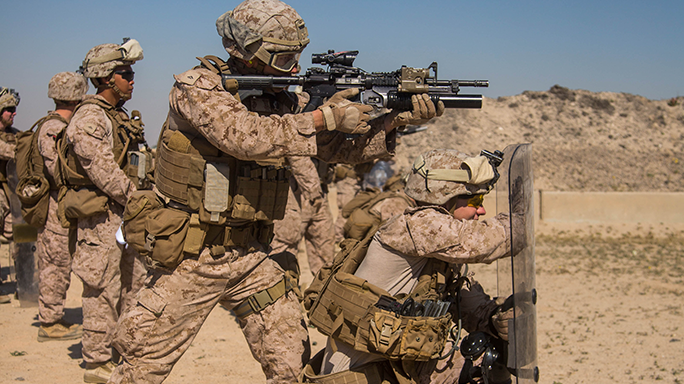The following is a release from Sgt. Owen Kimbrel, I Marine Expeditionary Force:
Platoon-sized riot control requires unit cohesion, proficiency with non-lethal weapon systems and an understanding of the proper procedures used to safely administer non-lethal munitions and techniques in a hostile environment.
- RELATED STORY: Marines Test New Counter-IED Training Course at Pendleton
In order to gain these, U.S. Marines with 1st Battalion, 7th Marine Regiment’s Company C, Special Purpose Marine Air Ground Task Force-Crisis Response-Central Command, performed a non-lethal weapons live-fire range at an undisclosed location in Southwest Asia, Feb. 10, 2016.
Advertisement — Continue Reading Below
The Marines alternated course of fires between the M4 shotgun and M203 grenade launcher with non-lethal rounds and then utilized those weapon systems tactically with riot shields. The Marines with shields stood shoulder-to-shoulder to form a protective barrier in order to allow the Marines with the non-lethal munitions to safely fire the hard rubber projectiles at the targets. These methods allow the Marines to safely deter any noncompliant entity without causing serious bodily harm.
“This training is important because being a part of a crisis-response [unit] we have the ability to be able to reinforce any American or coalition force within the [U.S.] Central Command area of operation,” said U.S. Marine 1st Lt. Justin Villanueva, a platoon commander with Company C, 1/7. “This allows us to be more than just a one trick pony; it gives us another tool in our tool belt which makes us more effective.”
Having these non-lethal capabilities ensures the Marines will be able to handle any hostile situation, should one arise.
Advertisement — Continue Reading Below
“I think it’s great that the command can give us extra training to allow us to be well rounded and lets us achieve what we want to be which is United States Marines,” said U.S. Marine Lance Cpl. Tanner Walker, a rifleman with Company C, 1/7.
























